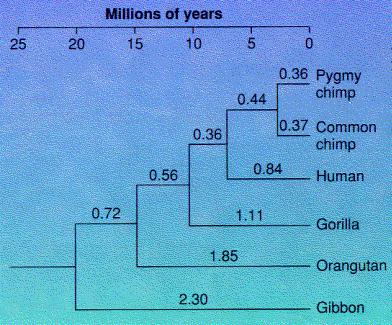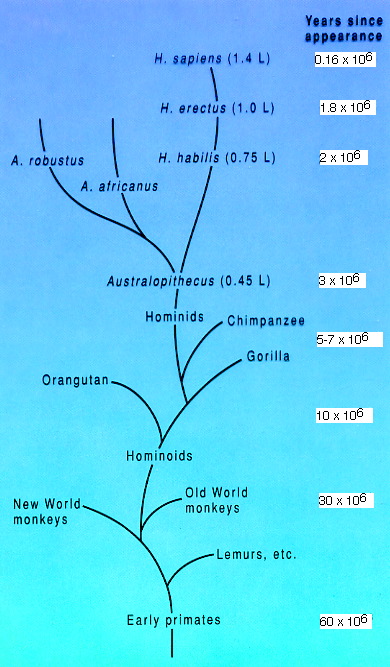A Phylogeny of Living Hominoids

This phylogenetic tree of living hominoids is based on DNA-DNA hybridization data (the work of Charles Sibley and Jon Ahlquist at Yale University).
The numbers represent the differences between various measured T50H values split up and apportioned to each branch.
For example, the T50H difference between the common chimpanzee (Pan troglodytes) and the pygmy chimpanzee or bonobo (Pan paniscus) is 0.7. Assuming that their DNA has evolved at the same rate since they diverged, each branch is given one-half that value.
The difference between the T50H values of humans and the chimpanzees is about 1.7, whereas that between the chimpanzees and the gorilla is 2.3. This indicates that humans and chimpanzees have shared a common ancestor more recently than chimpanzees and gorillas have.
The time scale was calibrated using fossil evidence that the line to the orangutan diverged some 13–16 million years ago.
The Human and Chimpanzee Genomes
Now that
- the actual nucleotide sequence of the human genome is known [Link] and
- that of the chimpanzee is almost known,
it is possible to make more direct comparisons between the two species.
The results:

- Their genomes are 98.8% identical (between any two humans — picked at random — the figure is closer to 99.9%).
- Comparing over 7,000 genes that occur in both species (as well as in the mouse), it turns out that slightly over 1,500 of these have evolved quite differently in the two species.
- In humans, genes for hearing, speech, olfaction — among others — have evolved rapidly since the two species diverged, while
- in chimps, genes involved in formation of muscle and skeleton have evolved more rapidly.
- In addition to the differences in the proteins these genes encode, differences between chimps and humans may also involve changes in regulatory sequences — promoters and enhancers — of their structural genes. So even if a gene product is quite similar in the two species, how and where it is expressed might be quite different.
- One gene product that is different between the two species is a protein designated myosin heavy chain16 (MYH16). In the 25 March 2004 issue of Nature, Stedman et al report that
- in chimpanzees (as well as pigmy chimps, gorillas, orangutans, and Old World monkeys), the MYH16 gene is expressed almost exclusively in their jaw muscles where it transcribed and translated to produce one form of myosin that is used in the thick filaments of their jaw muscle fibers.
- In all humans, the MYH16 gene has a deletion producing a frameshift that results in a premature STOP codon (a nonsense mutation), and thus the myosin molecule is too short to make effective thick filaments.
- The result in humans is jaw muscles that must rely on other myosins which produce fibers much thinner than those of the other hominoids and a much smaller muscle.
- From these data, the authors speculate that
- because smaller — and thus weaker — jaw muscles would exert less force on their bony attachment (the cranium),
- this would allow more flexibility and the potential for greater growth of the cranium during childhood and thus allow for the larger brain found in humans and their Homo ancestors (e.g. Homo erectus).
- The authors date the origin of the mutation to approximately 2.5 million years ago, when fossil evidence indicates that the line leading to the genus Homo — with brain cases growing from 0.75 to 1.4 liters — split from the Australopithecus line with its brain case of less than half a liter (see figure).
30 August 2005

